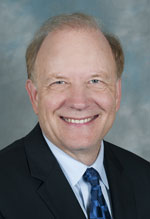
Field: Psychology
Works at: University of Washington, Seattle
Alternative career: Full-time rock ‘n’ roll drummer
Hobbies: Part-time rock ‘n’ roll drummer (with his band, the Shrinking Heads)
Credit: Clare McLean, UW Medicine Strategic Marketing & Communications
The pain stemming from second- and third-degree burns is among the worst known. Throughout recovery, the intense, disabling pain patients feel can lead to sleeplessness, anxiety and depression.
David Patterson first entered a burn ward as a psychologist hoping to help patients cope with these issues. He saw patients refuse wound cleaning because of how painful it could be.
“I’ve learned how horribly difficult it is to control burn and trauma pain with medications alone,” he says. “The amount of pain people feel affects how well they adjust in the long term.” Pain and the mental, social and emotional problems it causes also hinder the body’s ability to heal physically.
Today, Patterson is committed to helping burn patients overcome pain, allowing their bodies—as well as their minds—to heal more efficiently. Using virtual reality (VR) technology, Patterson has found an effective complement to pain-relieving drugs such as morphine and other opioid analgesics.
Patterson’s Findings
“To be honest, for acute pain, you give someone a shot or a pill and it’s instant relief,” Patterson says. But opioid analgesics carry problems. Sometimes patients don’t respond well to morphine or require high dosages that carry strong side effects.
When burn patients undergo routine wound care, the pain can be excruciating—as bad as or worse than the original burn incident. Realizing the brain can take only so many stimuli, Patterson collaborated with fellow UW psychologist Hunter Hoffman to experiment with VR in pain relief. When combined with minimal pain medications, VR is a powerful solution to acute pain. By providing a computer-generated reality—for example, an icy canyon filled with snowmen and Paul Simon’s music, as in the case of their creation SnowWorld—the patient’s eyes, ears and mind are so occupied that he or she can effectively ignore the pain.
Patterson and his team found that VR pain reduction strategies are as powerful as opioid analgesics, without the negative side effects. The technology doesn’t require specialized expertise and is getting progressively less expensive, making it economically attractive. At least eight hospitals have adopted the methods as part of their clinical program, allowing Patterson an opportunity to conduct further studies on the long-term effects of using these complementary methods and the efficacy of the techniques on other kinds of pain.
Learn more:
SnowWorld News Segment Featured on NBC’s Rock Center ![]()


What a wonderful idea. These people are angels.
We have used alternative pain strategies on the east coast at Yale and elsewhere. The problem for me and others suffering extreme pain from spinal injuries and ILD from being first responders at Ground Zero is, VR is stationary;limited to time and place. I do better with 24hr transdermal meds and meditation.